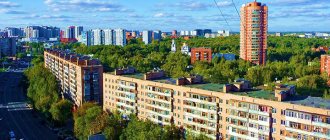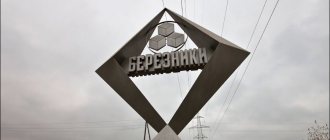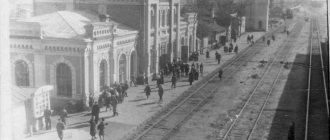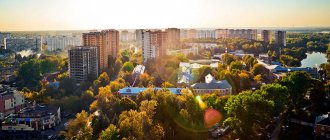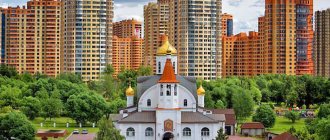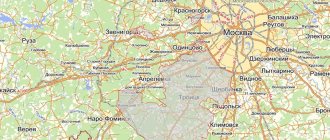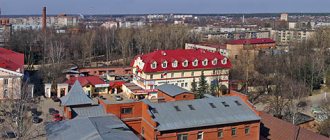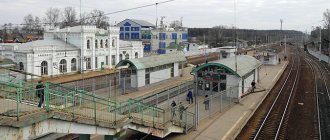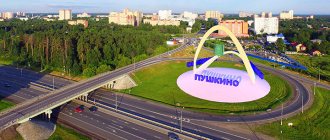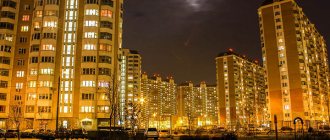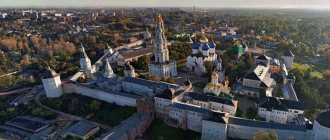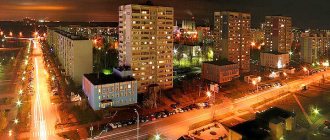The city of Khimki is located just outside the Moscow Ring Road, on the banks of the canal. Moscow, along the Moscow-St. Petersburg highway (Leningradskoye Shosse), adjacent to the capital from the north-west.
The city with a population of 250,000 people received the status of a separate urban district, and is conditionally divided into Old and New Khimki, and they, in turn, consist of the microdistricts: Skhodnya, Podrezkovo, Klyazma-Starbeevo, Novogorsk, Levoberezhny, Planernaya and Firsanovka.
Transport accessibility
Road communication with Moscow is very well developed; there are many roads here: this is the Leningradka highway and its toll backup, as well as Kurkinskoye, Novokurkinskoye, Novoshodnenskoye highways. However, the traffic congestion is so high that during working hours there are almost always traffic jams in Khimki (this is also due to the fact that there is a lot of transit transport to St. Petersburg, as well as a large number of shopping centers where Muscovites come to shop).
By public transport from Moscow you can get here from the station. metro stations "Komsomolskaya", "Petrovsko-Razumovskaya" (Electric trains of the Leningrad direction), "Rechnoy Vokzal" and "Planernaya" (buses and minibuses).
Option No. 2
Khimki is a beautiful city located in the Moscow region with its own great and interesting history.
Geography and history
In Russia, on the territory of the Moscow region in 1939, the city of Khimki was formed. In the 1950s Khimki was one of the most important centers of the space and rocket industries, due to the fact that the main defense enterprises were located in the city. The city is located on the banks of the Moscow canal, borders the MKAD (Moscow Ring Road) in the north-west of the capital, and in the north-east it reaches such districts of Moscow as Kurkino and Molzhaninovsky. The following rivers flow through Khimki: Khimka, from which the city got its name, Klyazma, Skhodnya, Goretovka. In addition to rivers, there are reservoirs: Khimkinskoye and Klyazminskoye.
Population
At the time of its inception, the population of the city in 2021 is about 255 thousand people.
Cultural centers and educational institutions
There are many cultural centers in the city, such as: houses of culture and children's creativity, Khimki Drama Theater “Our House”, cinema, museums. Among the educational institutions: schools, technical colleges, colleges, higher education institutions, many libraries, as well as the central children's art school. Among other things, quite a large number of monuments dedicated to the residents of Khimki, who defended their native land during the Great Patriotic War, have been preserved. There are also many parks, squares and sports facilities.
Attractions
The most popular attraction in the city is the Khimki Art Gallery. S.N. Gorshin, which was founded in 1993, thanks to S.N. donated to the city. Gorshin's private collection of paintings from the early 19th and late 20th centuries. The gallery also has almost 500 rare books and about 11 thousand postcards depicting copies of works by Russian and foreign artists. In 1966, famous Soviet architects A. Mikhe, I.P. Ermishin, A.A. Agafonov erected a monument to the defenders of Moscow called “Hedgehogs”. The main meaning of the name is that the monument is a structure made of barbed wire and rails. These structures created barriers to enemy tanks, helping our soldiers in the fight during the war. In addition to the above, the city has a sufficient number of various attractions in the form of temples, parks, monuments and theaters.
History of the city's development
The city got its name because it arose on the Khimka River (it no longer appears on maps - it was absorbed by the canal system) as a station village that appeared during the construction of a railway that connected the two Russian capitals in 1851.
By the middle of the 19th century, it was a popular dacha place around the villages: Kireevo, Kozmodemyanskoye, Krasnye Gorki, and later, the Tolstoulov wasteland was built up with dacha villages, and all these places were united and called Khimki.
Along with the industrial boom of the late 19th and early 20th centuries, serious enterprises came to Khimki: a dyeing plant, a cloth and wool-spinning factory, and thanks to the traffic flow from Moscow to St. Petersburg, the area developed rapidly.
Then the revolution broke out, and after it, furniture and knitting factories appeared, and construction of the Moscow-Volga canal (part of the Moscow Canal) began. The canal was built in 1932-1937, in 1937 Khimki was given the status of a workers' village, and two years later - a city.
History of the city of Khimki
History of the city of Khimki
Khimki city
- since 1939, regional subordination in the Moscow region of Russia. One of the largest satellite cities of Moscow. Population - 232,066 people. (2015). Khimki is the second most populous city in the Moscow region after Balashikha (260,704 people). The Khimki district was abolished in 2005. The city of Khimki forms the Khimki urban district, located on the banks of the Moscow Canal. The city is directly adjacent to the north-west of Moscow (the border runs along the Moscow Ring Road), and also encircles the exclave Moscow districts of Kurkino and Molzhaninovsky from the west, north and east.
The city received its name from the Khimka River, on which the settlement that preceded the city was founded. The final origin and meaning of the river's name has not yet been clarified. In ancient times, the form Khinska, Hynska was used, in the 16th-17th centuries. - Khinka, Khimka, near individual villages - Khilka (upper reaches) and Vykhodnaya (lower reaches). The form of Khimki was finally established only in the 19th century. The form “khinka” can be associated with the appellative khin - “nonsense, trifles, nonsense” (Dal, IV): Russian dialect (Ryazan) “khinyu” - “useless, in vain.” This means that the Khinka is an insignificant river. Over time, the word “khin” became rarely used, and later ceased to be used at all and began to be perceived as incomprehensible. Its semantic connection with the name “Khinka” has been lost; it was rethought, perhaps under the influence of the word “chemistry” coming into use. It is also possible that the hydronym has a Baltic origin (Middle Lithuanian himinas - “moss”), or from the male name Khimka - a colloquial form from Efimiy (Fimka)[7]. The name is also associated with the concept of Khilka - the upper path (exit), since it is assumed that a trade route passed along Khimka (it is possible that along Skhodna (Vskhodna) they “ascended” to the watershed with Klyazma, and along Khilka they descended from it). According to data from the 19th century, pike, perch, roach, and chub were found in Khimki. In the heat, the river almost dried up and, with a width of 2 fathoms (4 m), the depth was 3 inches (about 13 cm). Currently, along most of the former bed of the Khimki River there is a canal named after. Moscow. The upper reaches of the Khimki River have been preserved in the area of the former village of Lobanovo.
Until the end of the 1920s, Khimki generally retained the character of a dacha area. In 1923, 1,805 people permanently lived in the village, and in 1926 there were already 2,876; they numbered (after merging with the Petropavlovsky dacha settlement) 359 houses. A school, library, club, outpatient clinic were opened, and a fire brigade appeared. The first-level school was opened in 1919 by former nobleman Vladimir Mikhailovich Bolotov, refusing a state salary. In 1928, the school was transformed into a school for peasant youth - ShKM), Bolotov was the director and teacher at the school; It was located where the entrance to the park is now located. L. N. Tolstoy. From this time on, the industrial growth of Khimki began. In 1928, a knitting artel was created, which later grew into a knitwear underwear factory. In connection with intensified construction, the Nikolsky Brick Factory began to operate all year round, and not just the season; reconstructed since 1931. At the same time, a factory for the production of furniture was built. The Spartak metal products artel became a large enterprise, and the settlement of the artel workers turned into Spartakovskaya Street. New residential villages have appeared: Lobanovsky, Chkalovsky, Central, Grabarovsky, Pervomaisky and Mebelny. In 1932, aircraft repair plant No. 84 of the Civil Air Fleet was founded in Khimki. Since 1937, Khimki received the status of a workers' village in connection with the start of the construction of aircraft plant No. 301 in the city (now NPO Lavochkina). As of June 26, 1938, the village had a population of 21 thousand people. In 1939, the first two multi-storey stone houses were built on Moskovskaya Street.
In the 1950s, Khimki became one of the most important centers of the Soviet rocket and space industry. The main enterprises of several defense research and production associations were located in the city. Among them was the Energomash Design Bureau, which provided development of rocket engines for intercontinental ballistic missiles and spacecraft launch vehicles. IKB Fakel was the parent enterprise for the development of anti-aircraft missiles, including missiles for the S-75 Dvina, 9K33 Osa, S-125, S-200, S-300 and others. NPO im. Lavochkin was involved in the development of surface-to-air and air-to-air missiles, cruise missiles and a wide range of spacecraft, including the lunar rover. In addition to the military space sector, the city developed a direction for the development of logging equipment. The leading institute was considered to be TsNIIMOD, then TsNIIME (Moskovskaya 21). In the 1970s in the Levoberezhny microdistrict, next to the Moscow State Institute of Culture, a 9-story building of a branch of the Lenin Library (departments of newspapers, dissertations and out-of-demand literature) was built. In the Novogorsk microdistrict there is the head university of the Ministry of Emergency Situations - the Academy of Civil Defense of the Ministry of Emergency Situations of Russia. In 1984, by a resolution of the Council of Ministers of the RSFSR, a significant part of the territory of the Khimki region was transferred to Moscow, including the lands around Kurkino, Molzhaninovka and Novo-Podrezkovo. As a result of this, the Khimki region was divided into two parts by the territory of Moscow.
Property Features
Mass housing construction began in Khimki in the 1930s, when the village of Levoberezhny and the northern part of the future city were built, and in the following decades - the Dubki area near the canal.
Then the construction of residential buildings moved to the south, where the city center then moved (the so-called New Khimki). Subsequently, housing was built for workers in the aerospace industry, which the city specializes in to this day.
If you are interested in apartments in new buildings in Khimki, consider the advantages of this city.
Firstly, Khimki occupies a strategically advantageous position between Moscow and Sheremetyevo - it has transport accessibility, jobs, and an economically developed, and therefore socially prosperous, area.
Secondly, there is a favorable ecological situation, an abundance of natural resources (forests), proximity to “big water” (the water area of the Moscow Canal, the Khimki Reservoir, the Klyazma and Skhodnya rivers).
A story about the Khimka River
I dedicate this literary opus to my childhood friends: Shurz, Kostya and Rustam - God grant you 100 years of life, and the main thing is never to regret anything.
A story about the Khimka River
Few people know that the name of the city of Khimki near Moscow came not because of the presence of chemical industry facilities in this place, but because of a small river called Khimka.
And those who have heard about Khimki, but have never seen it, contemplating the expanse of the Khimki reservoir, formed due to the flooding of the historically formed river bed, imagine it as a kind of “folk beauty, like a deep sea.” Well, maybe not as wide as the Volga, but certainly not narrower than, for example, the Moscow River in the Strogino area.
And only a few citizens who have specifically studied this issue are aware that Khimka once upon a time was the name of a small stream flowing from a large swamp located in the wilderness of the forest.
But there is no other stream in the world whose name would become a derivative for the name of so many settlements and even a large reservoir. At the beginning of the 19th century. the village of Timofeevskaya, located on the left bank of the Khimka River (the village began from the place of the current intersection of Pribrezhny Proezd with Leningradka), is renamed into the village. Khimki. In November 1851, the Khimskaya railway station, called “Khimka” for short, opened next to the river (photo below)
In the 19th century, the holiday village of Khimki arose near the station. After the revolution, the Khimki state farm was organized near it, at the beginning of this century it was renamed “KSPH Khimki”.
In the 30s of the last century, after the Khimki River bed was flooded with water from the Moscow-Volga canal, the Khimki Reservoir was formed.
And thanks to the three Soviet secret factories built in the 30s of the last century near the Khimki station, now known under the names “Energomash” (Repair Plant No. 84, founded in 1932, in 1942 received No. 456), JSC NPO Lavochkina (Plant No. 301, founded in 1937), and “Fakel” (plant No. 293, founded in 1939), where after the war engines for spaceships and cruise missiles were produced (and are still being produced), the holiday village of Khimki turned into a working one, began to grow rapidly and in 1939 received city status.
In the last century, the names Khimki Forest and Khimki Forest Park arose.
In 1964-65 a new Moscow microdistrict was built - Khimki-Khovrino, where I spent my childhood.
This is how the name of a small stream, sometimes completely drying up in the hot summer, became widely known in our country and even became famous throughout the world.
- «
Tributaries of the Khimki
The river has four tributaries of varying lengths. This:
- Grachevka (6 km) is a right tributary of the Khimki, flowing mainly in an underground reservoir. It originates on the outskirts of the city of Khimki, within which it comes to the surface in the form of the Barashkinsky Pond. The name of the river probably comes from the estate of the same name near Moscow.
- Chernushka (3.8 km) is the largest left tributary of the Khimki. The river flows out of a swamp near the Leningradskoye Highway. On the southeastern edge of the Pokrovskoye-Streshnevo forest park it forms a system of six small ponds.
- Vorobyovka (1.1 km) is a left tributary of the Khimki. The river begins near the intersection of the Moscow Ring Road and the railway and flows mainly through the territory of the Khimki forest.
- Zakharkovsky Stream (0.2 km) is the right tributary of Khimki, flowing in the area of Southern Tushino. Under Khimki Boulevard, it is enclosed in an underground reservoir and comes to the surface only in the form of a small bay of the Khimki Reservoir.
Underground Khimka
Approximately 10% of the river's total length is underground. Khimka has three underground sections in its lower reaches. One of them is a siphon under the Moscow-Volga Canal. In other words, in this case one river flows under another.
Underground, Khimka flows in two parallel concrete portals. Here it is quite shallow, but wide. In the underground channel there is a branch for the cable collector, which is also partially flooded with river waters. Along one of the portals of Khimki there is an iron bridge half a meter wide, which is used by MosCollector employees.
Ecological state of the river
The Khimka River today is not in the best condition. Its valley is actively polluted by oil products and construction waste; harmful substances enter the watercourse from the capital’s oversaturated highways.
Residents of areas adjacent to the river have repeatedly contacted various city authorities regarding the unsatisfactory environmental condition of Khimki. So, for example, at the mouth of the river on 8 Marta Street, 2a, in the spring of 2021, a spontaneous dump of used car tires was formed.
In the area of the Pokrovskoye-Streshnevo park, Khimka is a natural monument of local importance (since 1991) and is protected by the state. Here its valley is most landscaped. If you are lucky, on the banks of Khimki within the park you can meet a muskrat or a beaver.
A walk through the history of Khimki
Home / Press / Forward (Khimki) / Walk through the history of KhimkiMEMORY OF THE WAR
The monument to the defenders of Moscow “Ezhi” is a place known to all Khimki residents. There is evidence that in October 1941, several German tanks broke through our front, reached 23 kilometers along the Leningradskoye Highway and were destroyed by an anti-aircraft battery.
The monument to the defenders of Moscow in the form of symbolic anti-tank hedgehogs was erected in 1966 according to the design of architects: A. A. Agafonov, I. P. Ermi-shin, A. Mikha, engineer K. I. Mikhailov. Materials: stone, iron, reinforced concrete. Anti-tank hedgehogs, despite their simplicity of design, were one of the most effective barriers stopping the advance of tanks. They were invented by the Czech military, and Major General of the Red Army Mikhail Gorikker improved them; in the documents this invention is called the “Gorikker star”. A collision of a tank with a “hedgehog” disables its transmission units.
ROAD TO SPACE
The post-war years were also difficult. But life in Khimki quickly improved. The rapid development of Khimki was facilitated by the decision of the USSR government to create a center for the rocket and space industry here. Research and production associations for defense purposes have received permanent registration in our city: Design Bureau "Energomash" named after V.P. Glushko - the world's largest laboratory for the development of rocket engines for intercontinental ballistic missiles and spacecraft launch vehicles; IKB "Fa-1 Kel" named after P. D. Grushin is the parent enterprise for the development of anti-aircraft missiles, including missiles for anti-aircraft missile systems S-75 "Dvina", 9K33 "Osa", S-125, S- 200, S-300 and others; NPO named after S. A. Lavochkin is developing surface-to-air and air-to-air missiles, cruise missiles and a wide range of spacecraft, including the lunar rover. In addition to the military space sector, the city developed the development of logging equipment. The leading institute was considered to be TsNIIMOD, then TsNII-ME.
IMMEMORABLE
TIME
If we talk about the history of the area where the Khimki district is now located, then we need to start from time immemorial. On the banks of the Skhodnya River in the 60s of the last century, archaeological excavations were carried out on behalf of the Moscow History Museum, and history teacher Joseph Isaakovich Polyak and his students participated in them. The remains of ancient man were discovered here, and tools were found that were held in the hands of Neanderthals in the 11th millennium BC. History of the local
The place has its roots in the Neolithic and Paleolithic eras, evidence of which was discovered during archaeological excavations.
PALEOLITHIC - the first period of the Stone Age, the time of the existence of fossil man, a paleoanthropist who used
using chipped stone, wood, and bone tools, he was engaged in hunting and gathering. The Paleolithic lasted from the emergence of man (over two million years ago) until approximately the 10th millennium BC.
Neolithic - the new Stone Age is characterized by the retreat of the glacier, the appearance of dense forests, deep rivers and lakes.
Neolithic artifacts were found on the banks of the Skhodnya River: bracelets, axes, chisels, and grinding tools. Traces of a settlement were found here. Several unique items from those excavations are in the museum of Gymnasium No. 7.
In the 14th-15th centuries, Ivan Kalita’s “Spiritual Letter” tells about the Goretovka volost. Goretovka included several settlements. The Scribe Book of the 16th century speaks of the Goretov camp and the villages: Koz-lovo, Petrovskoye, Starbeevo, Kozmod-myanskoye; villages: Kire-evo, Ivashkovo, Krasnye Gorki and several wastelands.
In the 9th-12th centuries, the Skhodnya River was called Voskhodnya, it was full-flowing, and ships sailed along it. After the founding of St. Petersburg, the St. Petersburg highway was laid, which determined the development of our places; the villages of Butakovo, Kirillovka and Khimki appeared on the map.
WHAT WILL YOU NAME THE SHIP
- so he will float -
This proverb came to mind in connection with the toponymy of the river. It turns out that our countryman ancestors made a mistake by naming the river Khimka, because all that was left of it were memories. Bad name.
The toponymy of the river is associated with misfortune in the life of a serf girl. beloved of the Moscow prince. Her name was Khimka. According to legend, she drowned herself in the river when the prince fell out of love with her. The second legend says: the Khimka girl threw herself into the waters of the river, unable to withstand the bullying of her masters. There is a third version, and it is also sad: the name comes from the word “chimit”, that is, to scold. The river was the exit to the Moscow River, but the transition was very difficult, and those who faced the need to cross from one river to another lamented and cursed about such a difficult journey.
The river was full-flowing, up to 50 meters wide, but now all that remains of it is a small reservoir in the area of Opanasenko Street, next to the maternity hospital. Civilization has passed through here like a tank...
FIRST THERE WAS KHIMSKAYA STATION
Since 1851, when the Nikolaev Railway was built through this area, the Khimskaya station and station village appeared. Old-timers remember what the square next to the station looked like: there was a collective farm market, and a wooden bridge was built across the railway. There was also a train station. It was located on the side of the road where the Rodina Cultural Center stands.
Gradually the village grew and developed; a post office, a telegraph, a tavern, a restaurant, a pharmacy, trading shops appeared here, and a little later
- school, library, medical institution, fire department. Industry began to develop: a brick factory, a knitting artel appeared,
furniture factory, metal products enterprise "Spartak"; a little later - an aircraft repair plant. Naturally, the growth in the number of enterprises was followed by the formation of new villages: Lobanovsky, Chkalovsky, Mebelny, Pervomaisky. In 1937, Khimki received the status of a working village, and on March 26, 1939 - a city.
GREAT
CONSTRUCTION
In 1937, a grandiose hydraulic structure, the Moscow-Volga Canal, was built. He walked along the southeastern outskirts of the working-class village of Khimki. The canal builders, who came here from different cities and villages, settled in this area. The population of the outskirts has grown sharply.
The Moscow Canal is one of the largest in the world. Its length
— 128 kilometers. 11 locks were built here: one on the Volga, seven on the canal route, three on the adjacent section of the Moscow River; 11 dams, of which three are reinforced concrete; 5 pumping stations, 8 hydroelectric power stations, bridges, barrier gates, cargo and passenger terminals
moats, tunnels, lighthouses, a number of other structures - a total of 240 objects.
The canal was built in a record time of five years: from 1932 to 1937. The capital needed it: it lacked water. According to calculations, it turned out that in the foreseeable future Muscovites would drink all the water from the Moscow River. The implementation of plans for the construction of the canal was prevented by the First World War, then the civil war.
The canal originates on the right bank of the Volga near the former village of Ivankovo. In this place, a concrete dam was built that blocked the Volga, raising its waters high and forming the Ivankovskoye Reservoir, or the Moscow Sea. The sea spread 120 kilometers long and 8 kilometers wide. It is from this giant “bowl” that the continuous “feeding” of the channel occurs.
At the beginning of the summer of 1933, the Main Directorate of Camps (GULAG) moved prisoners from the White Sea Canal, the construction of which by that time was being completed, to the Moscow region. Dmitlag became the largest camp in the country, through which more than a million prisoners passed. Here they began to be called Canal Army men. One of the branches of the Dmit-lag "Khimlag" was located on the banks of the Khimka River, it existed until the end of the 50s.
At the Khimskaya station there was a one-story building that housed the construction management of the Khimki section of the canal. The site was headed by engineer A. V. Budasi. His descendants live in our district. Khimki residents distinguished themselves during the construction of the canal:
Shershakov, Kormilitsyn, Avdeev and Sobolev (names unknown).
Excavation work was carried out by hand, with shovels and wheelbarrows. The soil was transported beyond the edge of the canal, to the top. Because of groundwater, people had to work knee-deep in mud. Few survived this hard labor. The conditions in which the workers lived could hardly be called human. The barracks were dirty and cold. There was no place to dry clothes. The dead were buried without coffins in common pits.
BRIDGES AND
RESERVOIR
Many Khimki residents consider the bridge over the canal to be a symbol of Khimki. This is the first reinforced concrete single-
arch bridge. Its length is 116 meters. Built according to the design of engineer A.I.
Petrova.
The history of the construction of the road bridge on the Leningradskoe Highway is interesting. At first there was a single-span steel bridge in its place; it was replaced with a modern one in 1960. It has recently been thoroughly renovated; in fact, now there are two bridges: one for transport going to Moscow, and the second for transport from the capital.
From here you can see a beautiful view of the Khimki Reservoir, along which ships sail. In the 30s, during the construction of the canal, a huge earthen dam was erected, blocking the Khimka River. The river water filled the pit dug in front of the dam, forming the Khimki Reservoir. The Khimki dam is the largest on the entire canal. Its height is 34 meters, length - 1600. The reservoir level is 36 meters higher than the level of the Moscow River. Ships overcome this rather steep descent using two locks: 7th and 8th. Under lock No. 8 there is a 186-meter-long Volokolamskoye Highway tunnel, and under the highway in this place the Chernushka River, a tributary of the Khimka River, flows through a pipe.
The canal was called “Moscow-Volga” for the first ten years, and in 1947, on the eve of the 800th anniversary of the capital, it received a new name.
"WALK
IN KHIMKI"
This is the name of the author’s program on the Khimki-Media TV channel. It was created so that the residents of Khimki do not forget the history of the city, and those who came to us recently and do not know how it all began here will become familiar with local history. Love for the Fatherland begins with love for the corner of the Earth where you live. By the way, dislike for the Motherland, if such a thing is possible, grows out of dislike for one’s city or village.
This is a topic for thought for our entire Khimki society: from teachers and local historians to journalists and literary
ditch We have to work hard for Khimki to prosper, which is what we are doing.
Vladimir KUZNETSOV.
